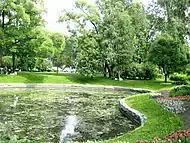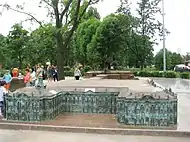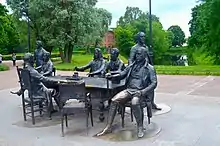Alexander Park (Saint Petersburg)



Alexander Park or Alexandrovsky Park (Russian: Алекса́ндровский парк) is a park on Petrogradsky Island of Saint Petersburg, Russia. It is one of the first public parks in St. Petersburg.
Structures
The park has a semicircular/crescent shape. The Leningrad Zoo is the largest occupant of the park. The other end of the park is the Northwestern Branch of the Russian State University of Justice. A canal separates the park from the Kronverk (now the Artillery Museum), which otherwise would be at the center of the area. To the south of the park and the Kronverk is the Kronverksky Strait, beyond which is the Peter and Paul Fortress.
The northern half of the park are occupied by (from west to east):
- an interactive children's theater (Skazkin Dom),
- Music-Hall (Мюзик-Холл): a medium-sized venue for plays and shows,
- St. Petersburg Planetarium,
- the Baltic House Festival Theatre,
- Velikan Park (Великан Парк "giant park"): a modern cinema with a food court,
- a couple of restaurants,
- Gorkovskaya metro station.
Artworks
It has the only outdoor miniature park in Russia: Mini-Gorod (Мини-город "mini-town").
The Architects (Зодчие), a bronze sculptural group by Alexander Taratynov was installed on June 15, 2011. Commissioned by Gazprom, it depicts the great architects of the Russian Empire. For a statue of a French architect Thomas de Thomon, the image of British chemist and mineralogist Thomas Thomson was mistakenly used. Taratynov blamed Wikipedia for the error but also himself for not checking with a historian to verify the image he used was accurate.[1][2]
References
- Jack Aitchison (20 August 2018). "Wikipedia gaffe sees statue to Glasgow professor erected in RUSSIA". Daily Record. Retrieved 19 August 2018.
- Ilya Kazakov (August 16, 2018). "Как Алексей Миллер подарил Петербургу вместо русского зодчего шотландского химика из Википедии" [As Alexey Miller presented to St. Petersburg instead of Russian architect Scottish chemist from Wikipedia]. Fontanka (in Russian). Archived from the original on August 20, 2018. Retrieved August 19, 2018.
The architect acknowledged the error and dumped the blame on Wikipedia, from which he downloaded the photo.